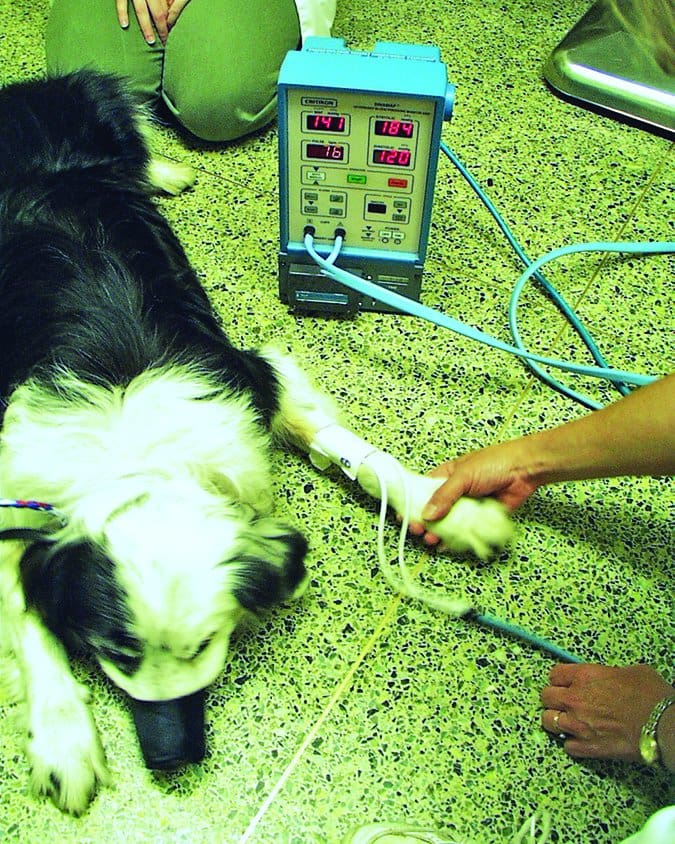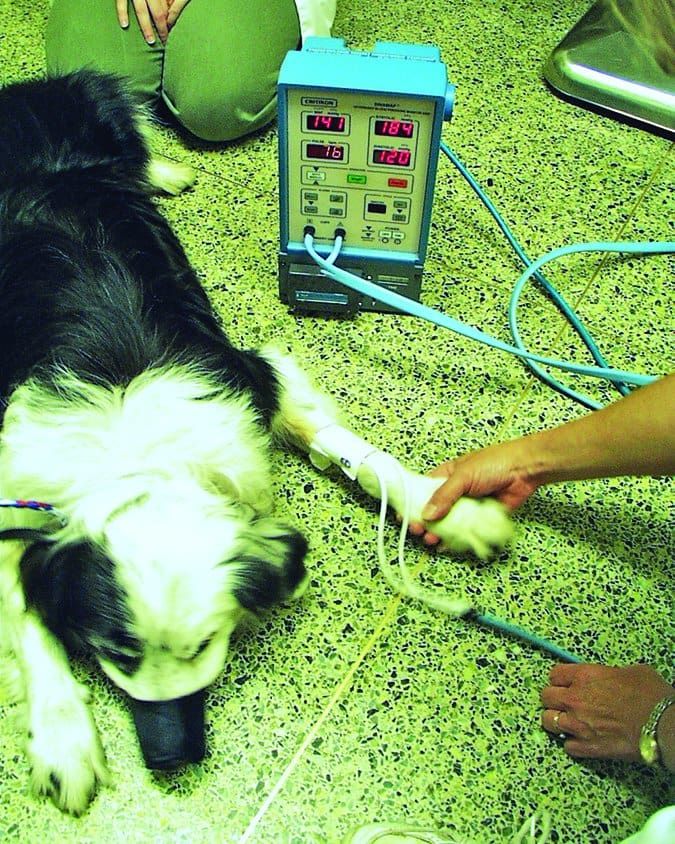A health exam for all adults includes a blood-pressure reading. So why not for our dogs? There are a few reasons that veterinarians save blood-pressure testing for only certain cases.
The first is money. Because vets constantly face clients who are unable or unwilling to pay for anything “unnecessary,” veterinary clinics are forced to offer a la carte services. The basic office-visit fee includes the veterinarian’s brief examination and writing applicable prescriptions. Anything else is an additional charge; veterinarians say this helps the client determine the cost of veterinary care.
“Veterinary exams would have to climb more than $100 per visit to include ancillary services that are ‘included’ in physician visits,” says Eve Ryan, DVM, of Baldwinsville, New York. “As unfortunate as it may be, many pet owners do not want or cannot afford all of the high-quality medical services that are recommended, so non-exam services are separated out.”
Another reason that veterinarians are hesitant to perform regular blood-pressure checks is because of the high incidence of false positives. “You don’t want to risk inappropriate treatment due to an invalid diagnosis,” says Bruce Kornreich, DVM, PhD, DACVIM, a cardiologist at the College of Veterinary Medicine at Cornell. “We don’t want to over-treat.”
Although an estimated 20 percent of humans suffer from “white-coat syndrome” (temporary high blood pressure caused by the anxiety associated with visiting the doctor), dogs aren’t as easy to sort out. “It’s reasonable to assume that dogs also suffer from white-coat syndrome,” Dr. Kornreich says, “but validation is different.” In human medicine, the patient sits quietly for a few minutes while the nurse prepares to take blood pressure. She might chat about the weather or an upcoming holiday to distract the patient’s thoughts, hopefully normalizing any white-coat effects. The blood-pressure reading itself is quick.
Visualize your dog in the veterinarian’s office, with the many smells, noises, and distractions. Just getting the dog to stand on a weight scale can throw him into a hyper state. Now add one or two staff members to restrain the dog and a Doppler ultrasound beep as the reading is done.
“It’s difficult to get blood pressures if the dog won’t stay still,” says Eileen Fatcheric, DVM, of Syracuse, New York. “The readings can be falsely elevated in a clinic setting, especially if the dog is anxious, and it is time-consuming.” Veterinarians are advised to take at least three readings – and preferably five to seven! – once the animal is quiet. The first reading is always disregarded.
Of course, the standard back-up plan physicians use is asking human patients to monitor blood pressure at home and report back to them. Over-the-counter human blood-pressure monitors are relatively inexpensive and foolproof. Get a cuff the right size for the patient and you’re good to go. Not so with dogs.
Types of BP Measurement

There are three main methods of measuring blood pressure in dogs. The gold standard is direct arterial monitoring, which is invasive (involving a catheter) and usually done only under anesthesia.
The Doppler ultrasound method is used in many clinics, but it, too, is not without drawbacks. “It involves a messy gel that is necessary for the probe to detect the pulse sounds, and operator error is a possibility,” Dr. Ryan says. “In my experience, the noise associated with the Doppler unit often frightens the animal unnecessarily. Headphones are available, but this mode is becoming outdated. New oscillometric devices used in modern veterinary medicine are well-calibrated, easy to use, reliable, and mess-free.”
Indeed, modern veterinary oscillometric devices – similar to human at-home blood-pressure measuring machines – have undergone dramatic improvement, and more veterinary clinics are utilizing them. But that doesn’t mean you can expect to buy a device at Walmart and take your dog’s blood pressure at home.
“Machines made for humans might give a ‘ballpark’ reading on a dog, but it wouldn’t be expected to be accurate, nor should it be used to make any medical decisions regarding medication or treatment,” Dr. Ryan says. “Only an animal-calibrated machine used with the appropriately sized cuff, used on the appropriate parts of the patient’s anatomy, should be used for medical decisions. Choosing the appropriate size cuff and its placement requires an understanding of the anatomy of the patient, which may change, depending on species and breed.”
When To Pay for a Blood-Pressure Check
There are times you won’t be offered a choice on blood-pressure reading fees, including during surgery, serious illnesses, shock, trauma, and IV treatments. If your dog has been diagnosed previously with high blood pressure or is on cardiac medications, blood-pressure monitoring may be a necessity. There are aspects of veterinary medicine your pet’s doctor will not negotiate.
“Patients with disease states that predispose them to hypertension – heart disease, Cushing’s syndrome, renal failure, among others – should be monitored, and therapy instituted before a hypertensive crisis occurs,” Dr. Ryan says. “Patients on medications that affect the blood pressure need to be monitored even more closely. A dog with certain health conditions, both acute and chronic, may present with high or low blood pressure, and this is often checked if needed, given the illness or situation.”
Some lay animal experts advocate that regular blood-pressure monitoring should be part of every canine veterinary exam, as it is with human exams. They are adamant that the service should be included in all wellness exams at a minimum, believing if blood pressure is checked regularly, you’ll know what normal is for that dog and be able to catch problems earlier, similar to human medicine. But it’s just not that simple.
The problem is that humans usually have primary hypertension, which is high blood pressure without a known cause. The most common reasons for high blood pressure in humans really don’t apply to most dogs: smoking, drinking, stress, high salt intake, lack of exercise, and obesity. (Those last two are increasingly applicable, of course.)
Dogs are more likely to have secondary hypertension, which means another disease is actually causing the high blood pressure. The most likely first offenders are kidney disease, diabetes, Cushing’s disease, and eye problems.
One place most veterinarians do press for routine blood-pressure screenings is geriatric wellness exams, but even then, money can complicate the decision. “In my senior pets, if money was an issue, I would choose physical exam first, then blood work, then urinalysis for my general health screening,” Dr. Fatcheric says. “If kidney, heart, thyroid, or adrenal disease was detected, I would strongly recommend blood-pressure monitoring. However, the earliest indicator of kidney disease is actually protein in the urine (microalbuminuria).”
Bottom Line
If your dog has been diagnosed with hypertension – whether due to an underlying disease or not – he will require monitoring, probably once every three months, plus applicable blood work and urinalysis. And that means regular trips to the veterinarian.
Be wary of those YouTube videos showing how to take your pet’s blood pressure with a human monitor. Research has shown that the proper cuff is a necessity and the placement of the device on hind limbs vs. forelimbs vs. tails will generate varying results, none reliable.
If you absolutely want a blood-pressure monitoring at each office visit, chances are all you have to do is pay for it. The wisest course of action is to discuss the option with your veterinarian.
“Every pet parent should have a veterinarian they trust and can have an honest conversation with regarding the best health care they can provide for that pet. Good health care is a team effort,” Dr. Ryan says. And part of that team effort is the decision about whether a blood-pressure check is a valid monitoring tool in your dog.
Cynthia Foley is a freelance writer and dog agility competitor from New York.







You stated that one of the reasons that routine vet checks omit blood pressure readings is that
” …. vets constantly face clients who are unable or unwilling to pay for anything “unnecessary”.
Have you not considered that the pharmaceutical and health equipment manufacturers, liability insurance companies, and even certain practices share blame in their profiteering of vet care? By placing blame on owners alone, you’ve not only shown bias, you’ve missed a fantastic -and journalistic- opportunity to discuss the multifactorial complexities of financing in modern veterinary healthcare.
Trisha : Well said and very important point. I’ve noticed that some vet offices charge more and all seem to be much higher than when I was younger. I’m of boomer age. I like to watch the Animal Planet show ” Dr Jeff Rocky Mt’n Vet. He routinely charges much less for care. One reason he said was that others had higher prices was that Vet school is so much more expensive now than it was in the recent past. Those costs, plus a Vet’s own expenses, contributed to the high medical bills. Probably a little greed at times. Nothing wrong with having a good, appropriate salary though. I retired and now wonder IF I can afford to have a dog. I’ve had a dog all my life. I’m not sure about pet insurance, hard to figure if it’ worth it. It’s an issue affecting many people. Thanks for listening , be well !!
How can I find out what is a good quality, reliable blood pressure monitor for home use for my dog? What brands do the clinics use? I feel if I monitor at home several times a week, my dog will get habituated to it and not freak out, thus the readings will be more reliable when we go to the vet.
My thought exactly. Did you ever get an answer to this question?
If we can do this correctly then I’m all for taking BP at home when our canines can be in a relaxed and quietly stressed free and be able to monitor regularly so it’s not something unusual for our loving canine. Humans are more likely to have higher BP so what’s to say it’s different for our animals!
Dog is so scared in vet’s office they cannot get valid reading. She has Cushing’s disease.
There is an entire market of AFFORDABLE home BP machines for people to take their blood pressure at home. But if you want to monitor your pet in between vet visits… I have to use a mobile vet for blood pressure, it’s $170 each time… there’s nothing for you. Oh there is an oscillometric brand from China, on Amazon and at Walmart. It’s gotten very mixed reviews. Apparently the cuffs provided are for children, not animals. Neonatal being the smallest, 6cm to 11cm. Google it in inches, you’ll see that may be too big for your cat or small dog. After that, you’re looking at $800 to $1400 dollars, assuming you can get a veterinarian or doctor to give you a prescription to buy a professional model. Right now with 2 cats who are elderly and have hyperthyroidism, CKD and are both on blood pressure meds…. these blood pressure reads are becoming a major expense. It burns me that I can’t find a decent veterinary BP monitor for home use for under $250.